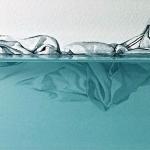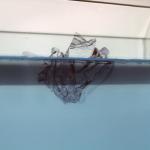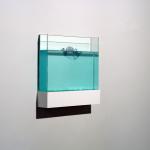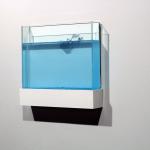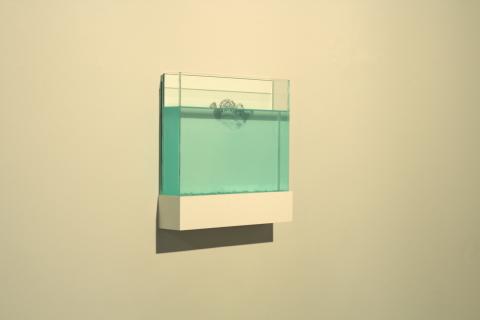Text by: Marisa Gómez
.
ENG
The transformation of the image of an object into something completely different is the exercise carried out by the Brazilian artist Rafaella Pacheco in her series "Icebergs de Quarto" (Room Icebergs, 2015).
Following a line of work that questions the meaning of everyday objects, Pacheco chooses something as common and banal as the duvets, understanding them precisely as an image of everyday life, but also as a metaphor for the privacy of the home, the room, the bed; as a space for direct contact with the body, with the bodies. It is precisely in this contact that the duvets often awake converted into sculptural figures, which serve the artist as a starting point for her plastic work.
First, she converts these "sculptures" into an image through photography, and subsequently she reproduces them as hyper-realistic watercolours. Then, the real process of subversion takes place: Pacheco reverses the reproductions and inserts them in aquariums, by placing the water line on the horizontal half of the painting. As a result of the refraction of light in the water, the image of the duvet - now cut by the horizon of bluish liquid - is distorted, changing with the angle of our gaze. But above all, it immediately transforms into the image of an iceberg, an irregular mass of matter, half above the surface of the water and half submerged.
This way, Pacheco achieves the superimposition of two opposite images: the duvet - whose function it is to heat - and the iceberg, a frozen object; the everyday and warm intimacy of the home and a cold, distant and desolate landscape.
As explained by the artist herself, the process is a kind of makeup. Thus, with a simple change of scenery, with a proposal of scenography, an everyday object becomes another thing and an image is transformed into something else.
ESP
Transformar la imagen de un objeto en algo completamente diferente es el ejercicio que hace la artista brasileña Rafaella Pacheco en su serie «Icebergs de Quarto» (2015).
Siguiendo una línea de trabajo que cuestiona el significado de los objetos cotidianos, en «Icebergs de Quarto» Pacheco elige algo tan común y banal como los edredones, entendiéndolos precisamente como imagen de la cotidianidad, pero también como metáfora de la intimidad del hogar, de la habitación, de la cama; como espacio de contacto directo con el cuerpo, con los cuerpos. Precisamente, en este contacto, los edredones amanecen a menudo convertidos en figuras escultóricas, que sirven a la artista como punto de partida para su trabajo plástico.
Primero convierte estas «esculturas» en imagen a través de la fotografía, para después reproducirlas como acuarelas hiperrealistas. Entonces llega el verdadero proceso de subversión: Pacheco invierte las reproducciones y las introduce en acuarios, situando la línea del agua en la mitad horizontal de la pintura. Por efecto de la refracción de la luz en el agua, la imagen del edredón - ahora cortada por el horizonte de líquido azulado - se distorsiona, cambiando con el ángulo de nuestra mirada. Pero sobre todo, se transforma inmediatamente en la imagen de un iceberg, una masa irregular de materia, mitad sobre la superficie del agua y mitad sumergida.
De esta manera, Pacheco logra superponer dos imágenes opuestas: la del edredón - cuya función es dar calor - y la del iceberg, un objeto helado; la de la intimidad cotidiana y cálida del hogar y la de un paisaje frío, lejano y desolado.
Como explica la propia artista, el proceso es como una especie de maquillaje. Así, con un simple cambio de escenario, con una propuesta de escenografía, un objeto cotidiano se convierte en otra cosa y una imagen se transforma en otra totalmente distinta.
PT
Transformar a imagem de um objeto em algo completamente diferente é o exercício que faz a artista brasileira Rafaella Pacheco em sua série «Icebergs de Quarto» (2015).
Seguindo uma linha de trabalho que questiona o significado dos objetos cotidianos, em «Icebergs de Quarto» Pacheco escolhe algo tão comum e banal como os edredons, entendendo-os precisamente como imagem do cotidiano, mas também como metáfora da intimidade do lar, do quarto, da cama; como espaço de contato direto com o corpo, com os corpos. Precisamente, neste contato, os edredons amanhecem muitas vezes convertidos em figuras escultóricas, que servem à artista como ponto de partida para seu trabalho plástico.
Primero converte estas «esculturas» em imagem através da fotografia, para depois reproduzi-las como aquarelas hiper-realistas. Então vem o verdadeiro processo de subversão: Pacheco inverte as reproduções e as introduz em aquários, situando a linha da água na metade horizontal da pintura. Pelo efeito da refração da luz na água, a imagem do edredom - agora cortada pelo horizonte de líquido azulado - se distorce, mudando com o ângulo de nosso olhar. Mas sobretudo, se transforma imediatamente na imagem de um iceberg, uma massa irregular de matéria, metade sobre a superfície da água e metade submersa.
Desta maneira, Pacheco consegue sobrepor duas imagens opostas: a do edredom - cuja função é dar calor - e a do iceberg, gelado; a da intimidade cotidiana e aquecida do lar e a de uma paisagem fria, distante e desolada.
Como explica a própria artista, o processo é como uma espécie de maquiagem. Assim, com uma simples mudança de cenário, com uma proposta de cenografia, um objeto cotidiano se converte em outra coisa e uma imagem se transforma em outra totalmente distinta.
IT
Trasformare l’immagine di un oggetto in qualcosa di completamente diverso è un esercizio compiuto dall’artista brasiliana Rafaella Pacheco nella sua serie «Icebergs de Quarto» (2015).
Seguendo una linea di lavoro che mette in questione il significato degli oggetti quotidiani, in «Icebergs de Quarto» Pacheco sceglie qualcosa di così comune e banale come i piumoni per rappresentare precisamente le immagini della quotidianità, ma anche come metafora dell’intimità del luogo, dell’abitazione, del letto; come spazio di contatto diretto con il corpo, i corpi. In questo contatto, i piumoni si convertono in figure scultoriche che servono all’artista da punto di partenza per il suo lavoro plastico.
Prima converte queste sculture in immagini attraverso la fotografia, per poi riprodurle in acquarelli iperrealisti. Arriva dunque al vero processo di sovversione invertendo le riproduzioni e introducendole in acquari: pone la linea d'acqua nella parte orizzontale della pittura. Come risultato della rifrazione della luce nell'acqua, l'immagine del piumone - tagliata dall’orizzonte del liquido blu - è distorta, cambiando l'angolo del nostro sguardo. Ma soprattutto, viene immediatamente trasformata nell’immagine di un iceberg, una massa irregolare di materia, metà sulla superficie dell'acqua e metà sommersa.
Pacheco riesce quindi a sovrapporre due immagini opposte: l’edredone - la cui funzione è quella di riscaldare - e l’iceberg, un oggetto di ghiaccio; la calda intimità quotidiana delle case e un paesaggio freddo, distante e desolato.
Come l'artista stessa spiega, il processo è una specie di trucco. Con un semplice cambiamento di scenario, con una proposta scenografica, un oggetto quotidiano diventa altro e un'immagine si trasforma in un’altra totalmente distinta.
GR
Η μεταμόρφωση της εικόνας ενός αντικειμένου σε κάτι εντελώς διαφορετικό είναι η άσκηση που κάνει η Rafaella Pacheco, καλλιτέχνης από τη Βραζιλία, στη σειρά της «Παγόβουνα δωματίου» (2015).
Ακολουθώντας μια γραμμή που αμφισβητεί το νόημα των καθημερινών αντικειμένων, στα «παγόβουνα δωματίου» η Pacheco επιλέγει κάτι τόσο κοινό όπως τα παπλώματα, εκλαμβάνοντάς τα ως εικόνα της καθημερινής ζωής, αλλά και ως μεταφορά για την οικειότητα του σπιτιού, του δωματίου, του κρεβατιού ως χώρου που έρχεται σε άμεση επαφή με το σώμα, με τα σώματα. Ακριβώς χάρη σε αυτή την επαφή, το ξημέρωμα βρίσκει συχνά τα παπλώματα μεταμορφωμένα σε γλυπτά, τα οποία εξυπηρετούν την καλλιτέχνη ως σημείο εκκίνησης για την μορφοπλαστική δουλειά της.
Πρώτα μετατρέπει αυτά τα «γλυπτά» σε εικόνα μέσω της φωτογραφίας, έπειτα τα αναπαράγει ως υπερρεαλιστικές υδατογραφίες. Στη συνέχεια, ακολουθεί η διαδικασία της ανατροπής: η Pacheco πλαστικοποιεί τις εικόνες και τις εισάγει σε ενυδρεία, τοποθετώντας την ίσαλο γραμμή στο μισό του πίνακα. Ως αποτέλεσμα της διάθλασης του φωτός στο νερό, η εικόνα του παπλώματος -που τώρα διαιρείται στα δύο από τον ορίζοντα του γαλάζιου υγρού- φαίνεται παραμορφωμένη, αλλάζοντας ανάλογα με τη γωνία του βλέμματος μας. Αλλά πάνω απ΄όλα, μετατρέπεται άμεσα στην εικόνα ενός παγόβουνου, μια ανώμαλη μάζα της ύλης, βυθισμένη κατά το ήμισυ στο νερό.
Έτσι, η Pacheco καταφέρνει να παραθέσει δύο αντίθετες εικόνες: το πάπλωμα - του οποίου η λειτουργία είναι να θερμάνει -και το παγόβουνο, ένα παγωμένο αντικείμενο· την θερμή καθημερινή οικειότητα του σπιτιού και ένα τοπίο ψυχρό, απόμακρο και έρημο.
Όπως εξηγεί η ίδια η καλλιτέχνης, η διαδικασία είναι ένα είδος μακιγιάζ. Έτσι, με μια απλή αλλαγή τοπίου, σαν μια σκηνογραφική πρόταση, ένα καθημερινό αντικείμενο γίνεται κάτι άλλο, και μια εικόνα μεταμορφώνεται σε μια εντελώς διαφορετική.



